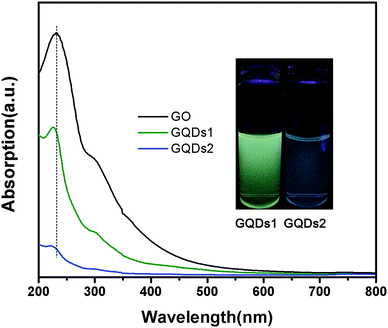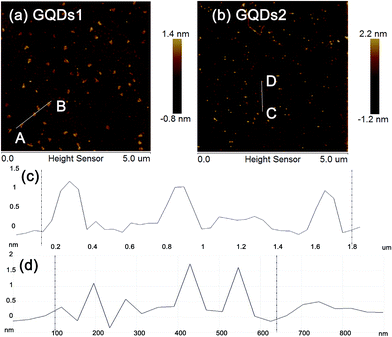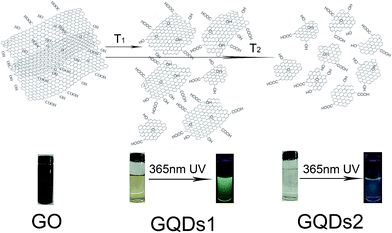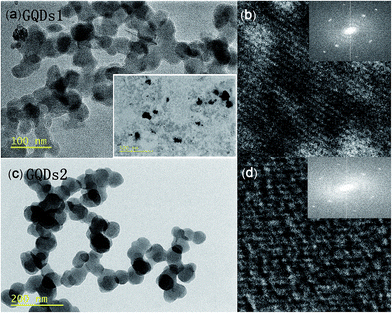Facile hydrothermal method to prepare graphene quantum dots from graphene oxide with different photoluminescences†
Renbing Tiana,
Suting Zhonga,
Juan Wua,
Wei Jiang*a and
Tianhe Wang*b
aNational Special Superfine Powder Engineering Research Center, Nanjing University of Science and Technology, 210094, Nanjing, China. E-mail: superfine_jw@126.com
bNanjing University of Science and Technology, 210094, Nanjing, China. E-mail: thwang56@126.com
First published on 7th April 2016
Abstract
A simple technique to prepare graphene quantum dots (GQDs) by the hydrothermal reaction of graphene oxide (GO) sheets with hydrogen peroxide is presented. Complete removal of the hydrogen peroxide after reaction was achieved by catalytic dialysis with manganese oxide. By varying the reaction time, the particle sizes of GQDs could be controlled, leading to variations in the photoluminescence. The prepared GQDs produced stable green and blue photoluminescence. The nanostructure of the prepared GQDs was characterized and discussed in relation to its preparation procedures and behaviours of photoluminescence. The mechanism of the reaction was also discussed.
Compared with two-dimensional nanosheets, zero-dimensional graphene quantum dots (GQDs) not only possess the intrinsic properties of graphene, such as a large specific surface area and thermal/chemical stability, but also a number of novel characteristics due to quantum confinement and edge effects.1,2 Although there have been numerous methods for the preparation of GQDs, they are categorized in either top-down or bottom-up strategies. The top-down methods refer to the cutting of graphene sheets via chemical,3–5 physical,6,23 and other techniques.7,8 Conversely, the bottom-up method involves stepwise synthesis of graphene moieties from organic precursors.9–11 The hydrothermal method is widely used in the preparation of GQDs from raw materials such as carbon black,12 carbon fibers,13 graphene oxide (GO),21,22 and graphite nanoparticles.14 Recently, a new technique based on the photo-Fenton reaction was proposed.15 GQDs with uniform lateral dimensions of 40 nm could be obtained from GO in a short time under ambient temperature from ultraviolet (UV) irradiation (365 nm, 1000 W). However, conventional hydrothermal methods involve treatments of the raw materials with nitric acid and sulfuric acid followed by a lengthy hydrothermal reaction, which brings about drawbacks of introducing a substantial quantity of acid radicals. Similarly, the solution after photocatalytic treatment by Fenton reagents also results in a large amount of ferric ions as unwanted by-products. Both of these two methods required lengthy and repeated dialysis to remove impurity ions because the concentrations of these ions, inside and outside the dialysis bag, can only reach a dynamic equilibrium. Besides, these techniques only allow GQDs with a single photoluminescence (PL) colour to be produced. Hence, there is a need for a facile, less time consuming, and inexpensive method for producing GQDs with multi PL colour capabilities.
Herein, we report a simple one-step hydrothermal method to produce GQDs via the reaction between hydrogen peroxide and GO in a high temperature and high pressure (HPHT) environment. Hydrogen peroxide was used to generate hydroxyl radicals (˙OH) under HPHT conditions as chemical “scissors” to cut down GO sheets. It is worth mentioning that different sizes of GQDs emit various PL and that different sizes of GQDs are obtained as the reaction proceeds. We can prepare GQDs with green and blue PL via controlling the reaction time. The GQDs prepared by this method were excited continuously for 24 h under ultraviolet lamp and showed no visible PL decay. This excellent stability implies the potential for applications in drug delivery and cellular imaging. The technique established in this work uses only common laboratory reagents and a Teflon-lined stainless-steel autoclave to provide HPHT conditions. The excessive hydrogen peroxide is conveniently eliminated via a simple and continuous catalytic decomposition. Therefore, the method has apparent advantages over other GQDs-making techniques and may reduce the cost of mass production significantly.
˙OH is a powerful oxidizing reagent with a standard electrode potential of 2.8 V.16 A possible mechanism of cutting GO by ˙OH was described previously.15 Carbon atoms connected to the hydroxyl and epoxide are attacked by ˙OH to break the C–C or C![[double bond, length as m-dash]](https://www.rsc.org/images/entities/char_e001.gif) C bonds, and then, the newly formed oxygen-containing groups serve as new reaction sites. The reaction mechanism between ˙OH and hydroxyl/epoxide was discussed by Bai et al.24 and Zhou et al.15 in detail. A possible mechanism of hydroxyl as a sample is shown in Fig. S1a,† this mechanism was repeated for the whole reaction and ˙OH break C–C bond (Fig. S1b†). In fact, the XPS results of GO, GQDs1 and GQDs2 also prove this mechanism. As shown in Fig. S2,† four peaks of C 1s at 284.9, 286.9, 288.1, and 289.4 eV correspond to C
C bonds, and then, the newly formed oxygen-containing groups serve as new reaction sites. The reaction mechanism between ˙OH and hydroxyl/epoxide was discussed by Bai et al.24 and Zhou et al.15 in detail. A possible mechanism of hydroxyl as a sample is shown in Fig. S1a,† this mechanism was repeated for the whole reaction and ˙OH break C–C bond (Fig. S1b†). In fact, the XPS results of GO, GQDs1 and GQDs2 also prove this mechanism. As shown in Fig. S2,† four peaks of C 1s at 284.9, 286.9, 288.1, and 289.4 eV correspond to C![[double bond, length as m-dash]](https://www.rsc.org/images/entities/char_e001.gif) C, C–O, C
C, C–O, C![[double bond, length as m-dash]](https://www.rsc.org/images/entities/char_e001.gif) O, and O–C
O, and O–C![[double bond, length as m-dash]](https://www.rsc.org/images/entities/char_e001.gif) O respectively. Obviously, the intensity of C–O decreased as the reaction preceded, which means hydroxyl and epoxide groups decreased gradually. Ultimately, large GO sheets are cut into small fragments. Hydrogen peroxide cleaves at high temperature to form ˙OH with activation energy of 48.5 kcal.17 According to the Arrhenius equation, it is easier to form ˙OH at higher temperatures. Therefore, the high temperature conditions provided by an autoclave are thermodynamically favorable for the reaction between ˙OH and GO sheets. On the other hand, at elevated temperature, hydrogen peroxide tends to decompose into oxygen. However, the pressure inside the autoclave at 170 °C would be high, which would restrict the decomposition of hydrogen peroxide and help to maintain a sufficient source of ˙OH. Therefore, it is concluded that the HPHT condition created by the autoclave was favorable to the H2O2/GO reaction both thermodynamically and kinetically.
O respectively. Obviously, the intensity of C–O decreased as the reaction preceded, which means hydroxyl and epoxide groups decreased gradually. Ultimately, large GO sheets are cut into small fragments. Hydrogen peroxide cleaves at high temperature to form ˙OH with activation energy of 48.5 kcal.17 According to the Arrhenius equation, it is easier to form ˙OH at higher temperatures. Therefore, the high temperature conditions provided by an autoclave are thermodynamically favorable for the reaction between ˙OH and GO sheets. On the other hand, at elevated temperature, hydrogen peroxide tends to decompose into oxygen. However, the pressure inside the autoclave at 170 °C would be high, which would restrict the decomposition of hydrogen peroxide and help to maintain a sufficient source of ˙OH. Therefore, it is concluded that the HPHT condition created by the autoclave was favorable to the H2O2/GO reaction both thermodynamically and kinetically.
GQDs were successfully prepared through the hydrothermal cutting method. The Experimental section is discussed in detail in the ESI.† Homolysis of hydrogen peroxide was used to produce hydroxyl radicals as “scissors” to break down GO sheets. Two samples (GQDs1 and GQDs2) were prepared under identical hydrothermal conditions (170 °C) but with different reaction times, 60 and 80 min, respectively. The product yield was 32% and 57% for GQDs1 and GQDs2, respectively. Part of the product after 60 min of hydrothermal treatment was larger than 200 nm, which was removed in a filter process via 0.22 μm membrane. So the product yield of GQDs1 was lower than GQDs2. Quinine sulfate was chosen as a standard for calculating quantum yield (QY), which was 3.6% and 5.3%, respectively (Table S1†). In Fig. 1a, GQDs1 and GQDs2 solutions after hydrothermal reaction without further treatment are shown. Fig. 1b shows GQDs1 and GQDs2 solutions after filtration through a 0.22 μm membrane and dialysis treatment. It is interesting to note that as the hydrothermal reaction proceeded, the brownish colour faded gradually and eventually became colourless. A group of photographs shows the colours and the PL properties of the solutions with increasing reaction time. As shown in Fig. S3,† the solution colour turned from brown to yellow and colourless when the reaction time increased from 60 min to 70 min to 80 min. Meanwhile, the PL of the solution was green, green, and blue when the reaction time was 60 min, 70 min, and 80 min, respectively. Besides, if the reaction time was extended to 4 h, the PL of the product solution disappeared. In addition, no GQDs can be found in the AFM image (as shown in Fig. S4†). After a long hydrothermal treatment time, the GO sheet was decomposed into small inorganic molecules.
 | ||
| Fig. 1 (a) Solutions after hydrothermal reaction without further treatment and (b) solutions after filtration and dialysis treatment. | ||
Fig. 2 shows the UV-vis absorption spectra of GQDs hydrothermally treated for 60 min, 80 min and GO sheets, respectively. An apparent blue shift from 230 to 225 nm is observed when GO sheets are cut into GQDs, suggesting a higher energy gap in GQDs. This is consistent with the quantum confinement effect.18 In the UV-vis spectra, two peaks can be observed. The peak at 225 nm is due to the π–π* transition of the aromatic C![[double bond, length as m-dash]](https://www.rsc.org/images/entities/char_e001.gif) C bond and the shoulder at 300 nm is assigned to the n–π* transition of C
C bond and the shoulder at 300 nm is assigned to the n–π* transition of C![[double bond, length as m-dash]](https://www.rsc.org/images/entities/char_e001.gif) O bond.28 For the former, π-electron motion in delocalized π bonds composed from sp2 carbons. Under a strongly oxidizing environment, previous sp2 clusters were destroyed, which influences the size of the sp2 clusters further. The energy gap of the π–π* transition depends on the size of the sp2 clusters or conjugation length.29 However, for the C
O bond.28 For the former, π-electron motion in delocalized π bonds composed from sp2 carbons. Under a strongly oxidizing environment, previous sp2 clusters were destroyed, which influences the size of the sp2 clusters further. The energy gap of the π–π* transition depends on the size of the sp2 clusters or conjugation length.29 However, for the C![[double bond, length as m-dash]](https://www.rsc.org/images/entities/char_e001.gif) O bond, with the size decrease of graphene oxide, the environment of electron movement did not change much. Therefore, there was a 5 nm blue shift in the π–π* transition and no obvious blue shift in the n–π* transition.
O bond, with the size decrease of graphene oxide, the environment of electron movement did not change much. Therefore, there was a 5 nm blue shift in the π–π* transition and no obvious blue shift in the n–π* transition.
 | ||
| Fig. 2 UV-vis absorption of GO, GQDs1 and GQDs2 in water. Inset: optical image of GQD solutions under UV light with 365 nm excitation. | ||
Raman spectroscopy was also employed to characterize the GQDs. The results indicate a G band of ordered sp2 bonded carbon and a D band of disordered carbon, respectively. As shown in Fig. 3d and a clear red shift is observed from 1590 cm−1 to 1620 cm−1 for GQDs. The intensities of D to G (ID/IG) have no apparent differences between GO sheets and GQDs.
Transmission electron microscopy (TEM) images (Fig. 3) show that GQDs2 had an average lateral dimension, of ∼60 nm. There are some large graphene sheets (with a size range between 50 and 200 nm) in GQDs1, as shown in the inset of Fig. 3a. This result indicates that as the reaction time was prolonged from 60 min to 80 min, the average size of GQDs were further reduced significantly. It is likely that this reduction of GQDs size caused the blue shift of PL, as shown in Fig. 2. The crystalline structure and electron diffraction pattern was observed in the high resolution transmission electron microscopy (HRTEM) images with a fringe lattice spacing of ∼0.252 and 0.249 nm, respectively, matching well with the data of graphite (0.246 nm) within the limit of error.19 Atomic force microscope (AFM) images with a scanning scope of 5 × 5 μm are shown in Fig. 4. Clearly, some larger graphene sheets (sized 50 to ∼200 nm) still existed in GQDs1 (Fig. 4a). This had inevitably affected properties of the solution colour and PL for GQDs1. The thickness for both GQDs was between 0.5 and 1.5 nm, corresponding to 1–3 graphene layers.
 | ||
| Fig. 4 AFM images of GQDs1 (a) and GQDs2 (b) with a scanning scope of 5 × 5 μm. Image (c) and (d) are the height profiles along the line from (A) to (B) and (C) to (D), respectively. | ||
The PL properties of GQDs are shown in Fig. 5. The GQDs synthesized after 60 and 80 minutes displayed green and blue emission colours at an excitation wavelength of 365 nm, respectively (Fig. 2). For GQDs1, when the excitation wavelength changes from 330 to 370 nm, the PL peak shifts from 450 to 510 nm, and the PL intensity alters correspondingly. GQDs2 share the same tendency. The excitation dependent properties of GQDs were also observed with other luminescent carbon nanomaterials.15 This may be interpreted by the fact that GQDs have different emissive sites and different sizes.12 As shown in Fig. 5c, the PL excitation (PLE) spectra were measured at the detection emission wavelength of 450 nm. Both samples have a maximum PLE intensity at 340 nm. It is interesting to find that the fluorescence intensity curve is fairly smooth when the solution is colourless, because there is a small amount of large GO sheets (but smaller than 0.22 μm) in the yellow solution (Fig. 1) and this affected the shape of the intensity curve (Fig. 5a). A detailed discussion of relationship between low impurities, PL spectra, and quantum yield is presented in the ESI.† The PL lifetimes curve was recorded for the GQDs transitions at 460 nm emission and 340 nm excitation by a transient fluorescence spectrometer. Both GQDs1 and GQDs2 were well fitted to a bi-tangent exponential function, as shown in Fig. S5 and S6.† Besides, the instrument response function and decay curve of GQDs1 and GQDs2 are also listed in black and red. For GQDs1, the observed lifetimes are t1 = 1.34 ns and t2 = 9.85 ns while the lifetimes are t1 = 1.81 ns and t2 = 10.31 ns for GQDs2. The lifetime in nanoseconds means the GQDs are suitable for biological, optoelectronic, and other applications. The existing explanations of the PL mechanism include defect state emission and intrinsic state emission caused by zigzag sites or electron–hole recombination.26 Wen et al. proposed that two spectral overlapped intrinsic (core) and extrinsic (surface) PL bands of carbon quantum dots and GQDs are responsible for the PL mechanism and excitation wavelength dependent PL.30 Zhu et al. used the defect state emission to explain the PL mechanism, which is related with the presence of oxygen-containing functional groups on the surface of GQDs.25 According to the XPS results (Fig. S2†) and UV-vis (Fig. 2) spectra, there is a quantity of oxygen-containing groups on GQDs. So it can be inferred that the PL mechanism could be explained by defect states caused by oxygen-containing groups located on the plane of the GQDs.27 The excitation wavelength dependent PL properties are also caused by the surface oxygen-containing functional groups that have different energy levels,12 as shown in Fig. S7.† The UV-vis absorption peaks at 225 nm (5.51 eV) and 300 nm (4.14 eV) correspond to the electron transitions of π–π* of C![[double bond, length as m-dash]](https://www.rsc.org/images/entities/char_e001.gif) C and n–π* of the C
C and n–π* of the C![[double bond, length as m-dash]](https://www.rsc.org/images/entities/char_e001.gif) O bond, respectively.
O bond, respectively.
A tentative mechanism is proposed here to interpret the different PL as observed with GQDs1 and GQDs2. As depicted in Fig. 6, ˙OH cut the GO sheets into small fragments as the hydrothermal reaction proceeded. The larger average size of GQDs1 resulted in a red shift in its PL as compared with that for GQDs2. This red shift in PL wavelength for GQDs1 was caused by the moderately larger particle sizes, and in principle, this is consistent with the quantum size theory.20
 | ||
| Fig. 6 Schematic of mechanism for the reaction and different PL. T1 is 60 min and T2 refers to 80 min. | ||
We have presented a simple but novel method to prepare GQDs by the hydrothermal treatment of GO sheets with hydrogen peroxide and a technique to purify them by a manganese dioxide catalyzed dialysis process. The facile method shows prominent advantages such as a one-step reaction, low time-consumption, continuous removal of the hydrogen peroxide, and perhaps the most interesting of all, controllable GQDs sizes leading to variations in PL. The nanostructure of the prepared GQDs were characterized and discussed in relation to its preparation and PL behaviours. By varying reaction time, GQDs exhibiting stable green and blue PL were produced. These features make it a competitive candidate for applications in biomedical fields.
Acknowledgements
This work was supported by a Project Funded by the Priority Academic Program Development of Jiangsu Higher Education Institutions.Notes and references
- C. O. Girit, J. C. Meyer, R. Erni, M. D. Rossell, C. Kisielowski, L. Yang, C. H. Park, M. F. Crommie, M. L. Cohen, S. G. Louie and A. Zettl, Science, 2009, 323, 1705–1708 CrossRef CAS PubMed
.
- L. A. Ponomarenko, F. Schedin, M. I. Katsnelson, R. Yang, E. W. Hill, K. S. Novoselov and A. K. Geim, Science, 2008, 320, 356–358 CrossRef CAS PubMed
.
- D. Y. Pan, J. C. Zhang, Z. Li and M. H. Wu, Adv. Mater., 2010, 22, 734–738 CrossRef CAS PubMed
.
- S. J. Zhu, J. H. Zhang, C. Y. Qiao, S. J. Tang, Y. F. Li, W. J. Yuan, B. Li, L. Tian, F. Liu, R. Hu, H. N. Gao, H. T. Wei, H. Zhang, H. C. Sun and B. Yang, Chem. Commun., 2011, 47, 6858–6860 RSC
.
- F. C. Liu, T. Tang, Q. Feng, M. Li, Y. Liu, N. J. Tang, W. Zhong and Y. W. Du, J. Appl. Phys., 2014, 115, 164307 CrossRef
.
- X. Sun, Z. Liu, K. Welsher, J. T. Robinson, A. Goodwin, S. Zaric and H. Dai, Nano Res., 2008, 1, 203–212 CrossRef CAS PubMed
.
- J. Güttinger, C. Stampfer, T. Frey, T. Ihn and K. Ensslin, Phys. Status Solidi B, 2009, 246, 2553–2557 CrossRef
.
- M. Zhang, L. L. Bai, W. H. Shang, W. J. Xie, H. Ma, Y. Y. Fu, D. C. Fang, H. Sun, L. Z. Fan, M. Han, C. M. Liu and S. H. Yang, J. Mater. Chem., 2012, 22, 7461–7467 RSC
.
- X. Yan, B. Li, X. Cui, Q. Wei, K. Tajima and L. S. Li, J. Phys. Chem. Lett., 2011, 2, 1119–1124 CrossRef CAS PubMed
.
- Y. Q. Dong, J. W. Shao, C. Q. Chen, H. Li, R. X. Wang, Y. W. Chi, X. M. Lin and G. N. Chen, Carbon, 2012, 50, 4738–4743 CrossRef CAS
.
- L. B. Tang, R. B. Ji, X. K. Cao, J. Y. Lin, H. X. Jiang, X. M. Li, K. S. Teng, C. M. Luk, S. J. Zeng, J. H. Hao and S. P. Lau, ACS Nano, 2012, 6, 5102–5110 CrossRef CAS PubMed
.
- Y. Q. Dong, C. Q. Chen, X. T. Zheng, L. L. Gao, Z. M. Cui, H. B. Yang, C. X. Guo, Y. W. Chi and C. M. Li, J. Mater. Chem., 2012, 22, 8764–8766 RSC
.
- J. Peng, W. Gao, B. K. Gupta, Z. Liu, R. R. Aburto, L. H. Ge, L. Song, L. B. Alemany, X. B. Zhan, G. H. Gao, S. A. Vithayathil, B. A. Kaipparettu, A. A. Marti, T. Hayashi, J. J. Zhu and P. M. Ajayan, Nano Lett., 2012, 12, 844–849 CrossRef CAS PubMed
.
- F. Liu, M. H. Jang, H. D. Ha, J. H. Kim, Y. H. Cho and T. S. Seo, Adv.
Mater., 2013, 25, 3657–3662 CrossRef CAS PubMed
.
- X. J. Zhou, Y. Zhang, C. Wang, X. C. Wu, Y. Q. Yang, B. Zheng, H. X. Wu, S. W. Guo and J. Y. Zhang, ACS Nano, 2012, 6, 6592–6599 CrossRef CAS PubMed
.
- K. Ikehata and M. G. El-Din, Environ. Eng. Sci., 2006, 5, 81–135 CrossRef CAS
.
- D. C. Conway, J. Phys. Chem., 1957, 61, 1579–1580 CrossRef CAS
.
- K. Sung, S. W. Hwang, M. K. Kim, D. Y. Shin, D. H. Shin, C. O. Kim, S. B. Yang, J. H. Park, E. Hwang, S. H. Choi, G. Ko, S. Y. Sim, C. Sone, H. J. Choi, S. K. Bae and B. H. Hong, ACS Nano, 2012, 6, 8203–8208 CrossRef PubMed
.
- Y. Baskin and L. Meyer, Phys. Rev., 1955, 100, 544 CrossRef CAS
.
- C. X. Xia and S. Y. Wei, Microelectron. J., 2006, 37, 1408–1411 CrossRef CAS
.
- M. Li, W. B. Wu, W. C. Ren, H. M. Cheng, N. J. Tang, W. Zhong and Y. W. Du, Appl. Phys. Lett., 2012, 101, 103107 CrossRef
.
- Q. Feng, Q. Q. Cao, M. Li, F. C. Liu, N. J. Tang and Y. W. Du, Appl. Phys. Lett., 2013, 103, 013111 CrossRef
.
- S. Zhuo, M. Shao and S. T. Lee, ACS Nano, 2012, 6, 1059–1064 CrossRef CAS PubMed
.
- H. Bai, W. T. Jiang, G. P. Kotchey, W. A. Saidi, B. J. Bythell, J. M. Jarvis, A. G. Marshall, A. S. Robinson and A. Star, J. Phys. Chem. C, 2014, 118, 10519–10529 CAS
.
- S. J. Zhu, J. H. Zhang, S. J. Tang, C. Y. Qiao, L. Wang, H. Y. Wang, X. Liu, B. Li, Y. F. Li, W. L. Yu, X. F. Wang, H. C. Sun and B. Yang, Adv. Funct. Mater., 2012, 22, 4732–4740 CrossRef CAS
.
- Z. C. Huang, Y. T. Shen, Y. Li, W. J. Zheng, Y. J. Xue, C. Q. Qin, B. Zhang, J. X. Hao and W. Feng, Nanoscale, 2014, 6, 13043–13052 RSC
.
- L. Tang, R. Ji, X. Li, K. S. Teng and S. P. Lau, Part. Part. Syst. Charact., 2013, 30, 523–531 CrossRef CAS
.
- S. H. Song, M. H. Jang, J. Chung, S. H. Jin, B. H. Kim, S. H. Hur, S. Yoo, Y. H. Cho and S. Jeon, Adv. Opt. Mater., 2014, 2, 1016–1023 CrossRef CAS
.
- G. Eda, Y. Y. Yue, C. Mattevi, H. Hamaguchi, H. A. Chen, I. S. Chen, C. W. Chen and M. Chhowalla, Adv. Mater., 2010, 22, 505–509 CrossRef CAS PubMed
.
- X. M. Wen, P. Yu, Y. R. Toh, X. T. Hao and J. Tang, Adv. Opt. Mater., 2013, 1, 173–178 CrossRef
.
Footnote |
| † Electronic supplementary information (ESI) available. See DOI: 10.1039/c6ra00780e |
| This journal is © The Royal Society of Chemistry 2016 |


